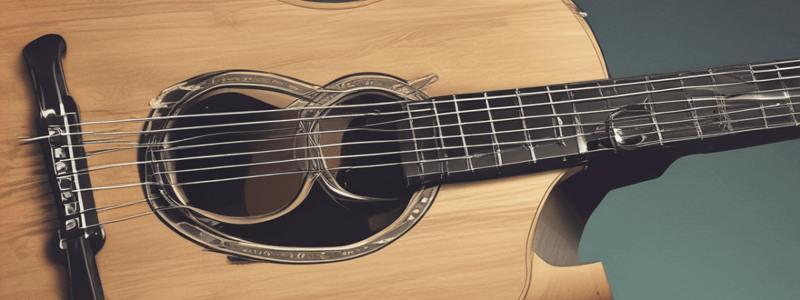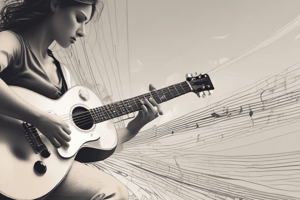Podcast
Questions and Answers
What is the correct finger placement for the D-Shape Barre Chord on the G string?
What is the correct finger placement for the D-Shape Barre Chord on the G string?
- Seventh fret
- Eighth fret (correct)
- Tenth fret
- Ninth fret
How many strings do you need to bar for the C-Shape Barre Chord?
How many strings do you need to bar for the C-Shape Barre Chord?
- The last three strings
- Only the high E string
- All six strings
- The first five strings (correct)
What is the recommended approach to transitioning between barre chords?
What is the recommended approach to transitioning between barre chords?
- Start with complex chord progressions
- Look down at your fretboard frequently
- Relax your hand and fingers (correct)
- Practice with only one barre chord shape
What is the purpose of rolling your index finger in the D-Shape Barre Chord?
What is the purpose of rolling your index finger in the D-Shape Barre Chord?
What is the primary function of the index finger in playing barre chords?
What is the primary function of the index finger in playing barre chords?
What is the basis of the major barre chord shape?
What is the basis of the major barre chord shape?
Why is it essential to memorize barre chord shapes?
Why is it essential to memorize barre chord shapes?
What is the recommended starting point for practicing barre chord transitions?
What is the recommended starting point for practicing barre chord transitions?
How is a minor barre chord played?
How is a minor barre chord played?
What should you do to your hand and fingers before practicing barre chords?
What should you do to your hand and fingers before practicing barre chords?
What is the characteristic of dominant 7th barre chords?
What is the characteristic of dominant 7th barre chords?
How many fingers do you need to position for the C-Shape Barre Chord?
How many fingers do you need to position for the C-Shape Barre Chord?
How is a minor 7th barre chord played?
How is a minor 7th barre chord played?
What is a recommended tip for mastering barre chords?
What is a recommended tip for mastering barre chords?
What is the result of too much pressure on the index finger in a barre chord?
What is the result of too much pressure on the index finger in a barre chord?
What is the ultimate goal of mastering barre chord finger positions?
What is the ultimate goal of mastering barre chord finger positions?
What is the importance of proper finger placement in playing barre chords?
What is the importance of proper finger placement in playing barre chords?
What is the characteristic of barre chords?
What is the characteristic of barre chords?
What is the primary way to play a barre chord?
What is the primary way to play a barre chord?
Why is it important to adjust your guitar's action?
Why is it important to adjust your guitar's action?
How do you transpose a barre chord shape to different frets?
How do you transpose a barre chord shape to different frets?
What is a common barre chord progression?
What is a common barre chord progression?
What can cause string buzzing when playing barre chords?
What can cause string buzzing when playing barre chords?
What is a characteristic of the E-shape barre chord?
What is a characteristic of the E-shape barre chord?
How do you play an A-shape barre chord?
How do you play an A-shape barre chord?
What is a benefit of practicing barre chords?
What is a benefit of practicing barre chords?
Why is it important to practice barre chords daily?
Why is it important to practice barre chords daily?
What is a common problem when playing barre chords?
What is a common problem when playing barre chords?
Why is it important to practice transitioning between barre chords in both directions?
Why is it important to practice transitioning between barre chords in both directions?
What is the purpose of using a pivot finger when transitioning between barre chords?
What is the purpose of using a pivot finger when transitioning between barre chords?
Why should you avoid keeping your hand pressed firmly against the neck when transitioning between barre chords?
Why should you avoid keeping your hand pressed firmly against the neck when transitioning between barre chords?
What is the main benefit of developing finger independence when transitioning between barre chords?
What is the main benefit of developing finger independence when transitioning between barre chords?
What should you prioritize when transitioning between barre chords?
What should you prioritize when transitioning between barre chords?
What is the purpose of using transitional chords when transitioning between barre chords?
What is the purpose of using transitional chords when transitioning between barre chords?
How often should you practice transitioning between barre chords?
How often should you practice transitioning between barre chords?
What is the result of consistent practice when transitioning between barre chords?
What is the result of consistent practice when transitioning between barre chords?
Study Notes
Barre Chords
- Barre chords are an essential technique for guitarists, allowing them to play chords across the fretboard.
- They are versatile and can be used in many different musical genres.
Understanding Barre Chords
- Barre chords involve using one finger (usually the index finger) to press down multiple strings across the fretboard.
- They are movable shapes that can be played in different positions on the guitar neck.
- Barre chords are named after the finger used to hold down the strings, which acts like a capo or bar.
Types of Barre Chords
- Major Barre Chords:
- Based on the E and A open chords.
- Played by barring all strings with the index finger and forming various chord shapes with other fingers.
- Minor Barre Chords:
- Based on the same shapes as major barre chords but with a minor tonality.
- Played by lowering the third (or middle) finger by one fret.
- Dominant 7th Barre Chords:
- Add a bluesy sound to playing.
- Played by lowering the third (or middle) finger by one fret and adding the pinky finger to form the 7th interval.
- Minor 7th Barre Chords:
- Have a mellow and jazzy sound.
- Played by lowering both the third (or middle) and fourth (or ring) fingers by one fret.
Tips for Mastering Barre Chords
- Warm-up and stretch before attempting barre chords to improve flexibility.
- Place the index finger as close to the fret wire as possible for better leverage and minimize string buzzing.
- Use arm and shoulder muscles to exert pressure instead of relying solely on finger strength.
- Adjust the guitar's action if necessary to make playing barre chords easier.
- Practice daily to develop strength and accuracy in playing barre chords.
Transposing Barre Chords
- Once learned, barre chord shapes can be easily transposed to different frets to play different chords.
- To move a major barre chord shape, simply slide it up or down the fretboard, keeping the same shape and barring the necessary fret.
- Can transpose minor, dominant 7th, and minor 7th barre chord shapes to different positions on the fretboard.
Common Barre Chord Progressions
- I-IV-V progression (e.g., C-F-G in the key of C).
- vi-IV-V progression (e.g., Am-F-G).
- "Rhythm changes" progression, used in many jazz standards.
Troubleshooting Barre Chord Problems
- String buzz:
- Caused by inadequate finger pressure or misaligned barre finger.
- Ensure proper finger placement and apply enough pressure to each string.
- Muted strings:
- Ensure fingers are not accidentally touching adjacent strings.
- Lift fingers slightly to give each string room to ring clearly.
- Struggling with finger strength:
- Practice regularly and incorporate exercises to build finger strength and dexterity.
Mastering Barre Chord Finger Positions
- E-Shape Barre Chord:
- One of the most commonly used and versatile barre chord shapes.
- Played by placing the index finger across all strings, third and fourth fingers on the corresponding frets, and strumming all strings.
- A-Shape Barre Chord:
- Another common chord shape that can be played up and down the neck.
- Played by barring the entire fret with the index finger, using second, third, and fourth fingers to form the A chord shape, and strumming all strings.
- D-Shape Barre Chord:
- Allows for easy transposition up and down the neck.
- Played by barring the entire fret with the index finger, using second, third, and fourth fingers to form the D chord shape, and strumming all strings.
- C-Shape Barre Chord:
- Frequently used in guitar playing.
- Played by barring the entire fret with the index finger, using second, third, and fourth fingers to form the C chord shape, and strumming all strings.
Transitioning between Barre Chords
- Relax hand and fingers to improve transition speed.
- Memorize chord shapes and their corresponding root notes to facilitate transition.
- Start with simple chord progressions and gradually increase complexity.
- Practice transitioning in both directions to ensure equal comfort.
- Use pivot fingers to make the transition smoother.
- Lift and adjust hand position to prepare for the next chord shape.
- Develop finger independence through exercises.
- Prioritize accuracy over speed when practicing transitions.
- Utilize transitional chords to bridge the gap between barre chords.
- Practice regularly to build muscle memory and improve transition skills.
Studying That Suits You
Use AI to generate personalized quizzes and flashcards to suit your learning preferences.
Description
Learn the essential technique of barre chords, versatile for various musical genres, and explore their aspects in this tutorial.



